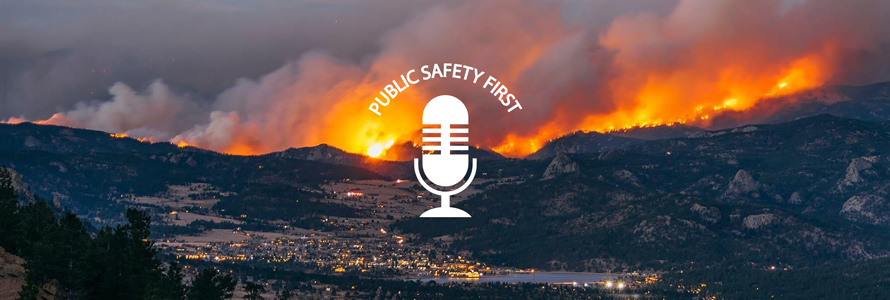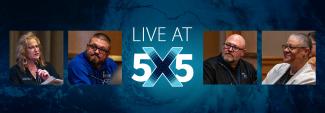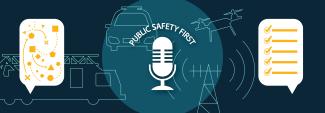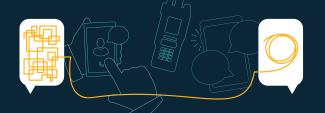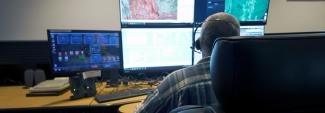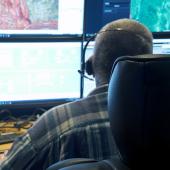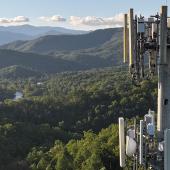Summary
The Cameron Peak Fire burned nearly 209,000 acres (326 square miles) in Colorado in late 2020, making it the largest wildfire in state history. As firefighters fought the blaze, FirstNet deployables and devices allowed them to access apps and resources that made their jobs easier and kept them connected to Incident Command and their families back home.
Guest
Tracey Murdock
FirstNet Authority Senior Public Safety Advisor
Don Patterson
Firefighter, Berthoud Fire Protection District, Colorado
Transcript
Preview
Narrator: You're listening to Public Safety First, a podcast to help you learn about the First Responder Network Authority and how you can be part of the future of public safety technology.
And now, your host.
Tracey Murdock: Welcome to the Public Safety First Podcast. I’m Tracey Murdock, and I serve as Senior Public Safety Advisor with FirstNet Authority. Today, I’m delighted to be joined by firefighter and communications expert Don Patterson, with the Berthoud Fire Protection District in Colorado. Don was deployed to the Cameron Peak wildfire, which is the largest fire in the history of Colorado. Don was instrumental in bringing “internet to the woods.” Thank you, Don, for joining us today and welcome to the podcast!
Don Patterson: Thank you. Thanks for having me.
Narrator: You're listening to Public Safety First, a podcast to help you learn about the First Responder Network Authority and how you can be part of the future of public safety technology.
And now, your host.
Tracey Murdock: Welcome to the Public Safety First Podcast. I’m Tracey Murdock, and I serve as Senior Public Safety Advisor with FirstNet Authority. Today, I’m delighted to be joined by firefighter and communications expert Don Patterson, with the Berthoud Fire Protection District in Colorado. Don was deployed to the Cameron Peak wildfire, which is the largest fire in the history of Colorado. Don was instrumental in bringing “internet to the woods.” Thank you, Don, for joining us today and welcome to the podcast!
Don Patterson: Thank you. Thanks for having me.
Tracey Murdock: Let’s start by learning a little bit about you. Could you introduce yourself and tell us a little bit about your background?
Don Patterson: Sure. So, I have over 20 years of communications and security experience. I’m a communications security engineer. I’ve supported multiple government agencies over the years in my past. I’ve served as a member on the fire service for over 18 years now, and I’ve earned qualifications and experience in over 30 active certifications—that spans structural fire, wildland special operations – I have multiple special operations team disciplines, including dive rescue, special operations disciplines, even into fire investigations and, of course, first responder peer support. I’ve been with Berthoud Fire since 2012. I’m a firefighter with them, but I’m also on their wildland team, their special operations, I do instructor, fire investigator, and peer support. And I’m a communications specialist with them. So, I deal a lot with our MDT, which is our Mobile Data Terminals. I deal with our cellular communications. I deal with our CAD [computer-aided dispatch] system with dispatch, and I deal with all of our cellular backhaul system. In my spare time I teach at the Aims Community College. I teach fire science. So, all that encompasses who I am and a lot about my background.
Tracey Murdock: Thanks, Don. That’s quite a background. So, given all that, can you talk about the Cameron Peak Fire? Talk about the size of it and what led you to be part of it?
Don Patterson: Sure. So, Cameron Peak is the largest wildland fire in Colorado history. The Cameron Peak Fire right now is almost about 209,000 acres. Roughly you’re talking almost 100 million dollars in that budgeting realm right now for that fire, which is staying 100% contained at this point. When I was there you had over 1,500 personnel on that fire, there was over 100 structures that were involved. And it’s superseded that now. When you talk about the mutual aid response, you’re talking 150 to 200 mutual aid engine responses that we would have throughout that fire. And that doesn’t even include law enforcement, local incident, EMS, localized citizens, organizations, businesses. But in the realm of communications, you’re talking 1,500 to 1,700 square miles of communications area that we’re trying to cover. You’re talking a straight line of sight of somewhere between 60 and 80 miles.
So, that’s a huge area, when you’re talking about the amount of area you’re covering in transportation and the level of communications that’s going to encompass that entire area. Because of the critical nature of the incident, we have to have communications blanketed in through that area as much as possible, and our goal is to, is to hit 100% if it’s possible. You know, with the fire expanding the way that it was, I mean you’re talking, a fire that literally jumped in its acreage, from 34,000 acres to over 100,000 acres in a matter of two days. So, the fire was moving very, very quickly, and there was just a lot of decisions coming down the pipe and we just had to make the right decisions at the time to get the communications where we needed it.
Tracey Murdock: Ok, so why were you called to support the Cameron Peak Fire?
Don Patterson: I had served many years in wildland as an engine operator firefighter. With my communications background, I’ve really tried to get more certifications and be tagged in more with communications field of wildland. I end up getting a call from the logistics chief of the Cameron Peak Fire. He said, “I need a comms person.” So, I came in as a RADO [Radio Operator] and Comm Tech trainee. When I entered the ICP [Incident Command Post] at Cameron Peak, we struggled with internet and we struggled with a lot of things. And in my background with the fire service, whenever I went out into the field, I would always bring my cellular equipment. And as we needed service, you know, especially with apps and data and email and things like that, I would literally set up my equipment and provide what I would tell my guys is “internet in the woods.” But then when I hit Cameron Peak it became further than that. I mean, we really started trying to utilize broadband and especially cellular broadband, and when I realized we had this problem with internet at the ICP, I approached my comms unit leader and talked to him about some of the ways that we might be able to resolve that. He basically had me go talk to the logistics chief at the time, and I gave my suggestions to her and she basically told me to go ahead and push those forward.
I had to communicate with Colorado State University, but once I had a technician from Colorado State come to the ICP, I was able to get that ICP up and running with gigabit internet within four hours. And before that they were saying it would be up to two weeks before we would have any solid internet. And so, it went from there. When we started looking at these forward operating bases, and we started looking at the need, especially with COVID. They were already doing remote check-ins where people were checking in online, demoding online. They weren’t going from yurt to yurt anymore, or tent to tent, getting these signatures like they used to. So, it became such a necessity to push the access out into the field, which really just hasn’t happened in the past. In my past fires that I’ve been on, that’s probably been our biggest struggle is we have radio communications, but then when we want to have that data connectivity, it just hasn’t been there. And so, for this fire, we started looking at, what do we need to do to try and get the service out there? And so, we started really looking at pushing the deployables further into the fields on the fire line. So, there’s some complexities in that. When that happened, I started talking about putting together the game plan, you know, the planning phase, the ordering phase, deployment, management, and even a demobilization of those assets. Once I started talking about that – you know how communication realm works – they said, “Oh, you know a lot about this. We want you to handle overseeing the deployables, as well.” And so that’s kind of how that started.
And then, of course, I’ve been researching FirstNet for a long time, really looking at the capabilities coming forward, and we had some struggles with other carriers, especially when it came to providing the service down the line. We were getting overwhelmed and oversubscribed, especially because we were close to neighborhoods, and we can’t dictate that. Well, with FirstNet, we could and I knew that. So, I started talking about deploying FirstNet deployables, and we were able to not only deploy FirstNet assets, but we were also able to deploy phones and hotspots, as well.
Tracey Murdock: What did you do to actually get the FirstNet deployable into the field?
Don Patterson: I had a lot of contacts with engineers and upper staff within other carriers, as well as with FirstNet, and so I was able to utilize those contacts and end up getting in contact with Michelle Vandaren, who runs the Western Region area. I made a phone call to Michelle, explained the situation, explained what my needs were. She emailed over a document that needed to be filled out. Of course, it had all of the particulars of the incident and location of where it was going to be and then I followed through with all of that documentation. She coordinated the asset, which was an actual SatCOLT [satellite cell on light truck] that came out, and we actually were able to get two of them for the incident. And one we actually deployed within a few hours upon requesting it because we had a COVID-19 exposure where we had a positive case, and we had to quarantine a whole forward operating base. So, we were actually able to get that relatively pretty quickly.
In general, it’s really not a difficult process, and I’ve found it to be very easy. We actually had very, very quick response, like I said, and on top of all that, the constant communication I had with Michelle at FirstNet and her team and even the guys who came out on the ground. The person who was in charge of bringing the generator and the people who came out who were in charge of setting up and deploying the FirstNet asset were all great. I had direct communications with them throughout the whole process. Even when we had to go to evacuation phases of those assets, I was really able to contact them very fast and we were able to put together a game plan for the evacuation and needs for those assets.
Tracey Murdock: Could you talk a little bit more about the evacuation?
Don Patterson: Sure. So, we had the fire, like I said, moving so rapidly at certain points where it could easily cover, you know, four miles in a single day, which is huge for a fire. And so, when a fire’s moving that fast, we have to be able to have these contingency plans be in place and have a trigger point for them and be able to initiate those plans. And that’s what happened. We had multiple assets actually out there between multiple carriers and FirstNet, and with the contingency plans in place, we had one of those assets that, unfortunately, because of where we ended up putting it with the COVID response, we knew that that one would be an evacuation position and not a shelter in place. And so, when we had to pull the trigger on that, we coordinated with FirstNet. We were able to literally coordinate that within 12 hours. And so that, that actually is very, very fast. Usually it can take 24 or more hours to coordinate a removal or a movement of those kind of level of assets. We were able to do that in less than 12.
Tracey Murdock So, Colorado has a mature LMR [land mobile radio] radio system for public safety. Could you talk a little about – how did you use FirstNet in the field? How did it change the way that you operate?
Don Patterson: So, like you said, Tracey, the LMR network is such a great network. That being said, every network has its challenges. LMR, cellular – it doesn’t matter. And so, with an LMR network, we were blanketing a lot of that area that we needed to. So, it was phenomenal what we were able to accomplish, but with the cellular broadband coming into the frontline of the fire, to me, that brings so much more capability. So, when you think of what we’re doing in fires, all of our guys are using applications. They’re using the internet, the web interface, they’re connecting into video footage, directly from our MMA, which is our Multi-Mission Aircraft that’s flying. All of that stuff is data-related. Avenza, which utilizes offline mapping. So, it uses PDF mapping. You can plot your tracks, you can mark waypoints and all that. Those are great, but the thing about the maps that are offline – we still need the updated maps daily, because those updated maps are being put out by GIS, which is back at ICP. So, to get even those maps you need data. You’ve got to have some kind of data connection to be able to pull those maps down off of a QR code and download them. Even with the newer style of collecting for our drop points and helispot points, we still utilize the radio for that, but to try and limit traffic on the radio and eliminate errors, they’re actually creating those GPS points now in an app called Collector, and that app is tied directly to the web so once you have a division who can put that information into Collector, they can immediately pull it right from the web and start working out the helispot information or the drop point information for that GPS coordinate.
We rely so much on applications, so much on data, our MDT terminals that we use in our rigs even for the fire service have become a necessity more than just something nice to have. It’s amazing how much we’ve engrained the technology that we have day to day into the emergency service realm of everything we do. And so, now, what I’ve seen with bringing cellular broadband into the field, is we’re enabling our guys to me, not be handicapped in that realm. And yes, we do need to always fall on basics, and I will always tell you that it would be great to have an LMR network. It’s great to know how to use a compass and a chart and all that. But the decisions when they are made up to the second, up to the minute, when you can imagine getting data that is up to the minute, you know, that’s a game changer. It’s absolutely a game changer. And so, now, you’re taking everything that we’re doing in our daily lives and you’re saying, yes, you’re now going to be able to take that into the field. You are now going to be able to update those maps. You’re able to pull down video of an actual flight that happened 15 minutes ago that can literally give you up-to-the-minute information on fire movement. It can even show you where your boots are on the ground because of the IR footage that you’re able to get from that aircraft.
Being able to do our timesheets was the other thing that I saw, which is a massive thing for our guys because, you know, the finance department is always trying to push it out in the field, “We need to have this done.” And so, to correct the financial thing, they would have to come back out of the field to be able to either submit timesheets or deal with a correction error – anything like that. Now, when you’re talking about a massive incident, you’re talking about four to six-hour turnaround to pull that person off the field, go and take care of a problem, and then come back onto the line. So, they’ve lost almost a complete day of work. And so, now we’re able to allow them to reach out into the field, they have the data connectivity, they can do their time cards, they can correct errors by logging online and being able to do those things for finance back at ICP, without pulling our resources off the line. And so, we’re not losing the productivity of that crew when we have a fire that’s moving four miles a day.
So, the overall importance of what we saw with being able to push the cellular broadband to the field was absolutely a game-changing experience from past incidents I’ve been on and when it comes time to making crucial on-the-ground decisions is when I saw that this just was astronomical. When we had the fire moving into certain areas and they were trying to get up-to-the-minute information and trying to talk back to ICP, trying to make decisions on where to do burnouts, those kinds of things, it was amazing how well they were able to utilize that information through cellular connection.
Tracey Murdock: So, you talked about all of the game-changing capabilities. Is there something that sticks out in your mind, a particular story or a particular incident that happened?
Don Patterson: Yes. One of the successes we had was during our COVID-19 response. We had one of our guys that came out. He was sick. We ended up utilizing AirLife to get him off the mountain. We come to find out that he did test positive for COVID-19. We ended up quarantining the entire forward operating base at Jacks Gulch Campground. That was over a hundred and some assets on the ground as far as people. And so, when you’re talking about a LMR network, that’s a lot of data to try and keep putting back and forth because we needed to know a lot of information about our people, we needed to know a lot of information about the situation, and it needed to be up to the minute, because we needed to know if other people were showing symptoms, when they were showing symptoms, how to get them tested, how to get them off the line, how to de-mobe people if there was an emergency, all those things needed to happen, and you could literally take down an LMR network if we had to do that. And so, when we did this, we deployed the FirstNet asset to Jacks Gulch Campground that night. We actually had 30 cell phones and over 20 hotspots that were deployed as well that we sent out, we were able to get out to the campground. And so, when we did that, it really allowed us to gain immediate connectivity to the people on the ground.
What I saw was such an important factor was the connection that we were able to get connected back to the people that really cared about us on the ground. Normally in the field, we have no way of contacting our family. They have no way of contacting us. And what I saw at Jacks Gulch Campground were guys able to communicate home, communicate back to their departments, letting their departments and their families know that they’re okay and not only that they’re okay, but, they’re being taken care of. And I think that that helps set the guys mentally on the ground when you’re in quarantine, because now you’re in quarantine, and yes you have the comradery of your guys, but you know your family is wondering what’s going on. And so, by being able to connect back to our families and have the peace of mind of knowing that your family’s not worrying about you and that you’re okay in their mind allows you to come back and do the job even harder. And so, to me, that was such a huge success.
Tracey Murdock: Excellent. So, you talked a lot about the successes and how broadband really changed it. I’ll bet you had some challenges. What were some of the challenges that you had to overcome with internet in the woods and getting the service that you needed?
Don Patterson: Some of the challenges we had when we started trying to put the internet in the woods or deployables out in the field was one, is who’s overseeing the resource? It’s a communications asset, but it’s also an information technology asset. So, when you have ITSS, for instance, running a lot of things with IT, and you have a COML [Communications Unit Leader] who’s running a lot of the communications, especially on the LMR side, it really came down to who needs to control and oversee the assets? And that was hit on pretty early and it was stated that the assets were going to be controlled by the communications unit and the COML, and then basically I oversaw the assets underneath the COML.
The familiarity of the technology and management of cellular assets, to me, was another thing. You have a lot of people in LMR that are now trying to expand their knowledge into this other side of things – cellular mobile and cellular broadband. And so, there’s no real position or task book that we’ve had in the past that really defined that level position that’s going to be handling cellular broadband. And so, we addressed that as well.
And then, of course, overcoming the proprietary cell bands. We had other cellular carriers utilized as well, plus FirstNet. The challenge we had to overcome was not everybody’s on FirstNet and not everybody’s on the other cell carriers. When we deployed a FirstNet asset, that’s one of the things I discussed earlier – we went ahead and we were able to obtain over 30 cell phones and 20 hotspots. And the hotspots were able to be utilized to allow the other phones to connect via WiFi, even though they were on another carrier. So, that still gave us a lot of success in that realm. But, that was a huge challenge.
The challenge I saw that we were able to overcome on cellular bands was oversubscription. When you have a cellular asset that is close to a lot of different areas, cell phones don’t care what they connect to. And so, unfortunately, we had cellular assets out there that were getting oversubscribed and it wasn’t enabling our guys to be able to utilize those assets. And so, we were able to help with FirstNet, utilizing Band 14. And when we were able to lock down the assets to Band 14, we saw a huge change in that where we controlled the traffic and we were able to utilize it and overcome that challenge.
And then, the biggest challenge that I saw was contingency planning. A lot of people didn’t understand the aspect of contingency planning when it came to these assets. I went out into the field and would survey areas looking at where those sites needed to be, creating trigger points on when we should be looking at either doing a shelter in place, or we’re doing an evacuation plan for that asset, and when that needs to happen. Because ultimately, the financial responsibility becomes huge. And if we were to burn over an asset, basically, I’m overseeing an asset that the incident could be charged for, and you’re talking upwards of 200,000, 500,000, depending on the level of that asset that the incident would be charged. And so, that’s something else that I looked at with FirstNet, too, is looking at how FirstNet handles that financial responsibility. It does take a lot of pressure off the incident and it takes a lot of pressure off of whoever is overseeing the assets to know that if for some reason, the contingency planning just didn’t work the way we needed it to, or the fire moved just out of control and we couldn’t plan for that incident, and we lost an asset, that FirstNet has a great way of handling that financial responsibility where it’s just not going to fall back on to me as an oversight, or the incident, when we already have so much to worry about.
Tracey Murdock: FirstNet is also a new technology, and not everybody’s aware of it. Can you talk about the reaction of the firefighters when you bring in this deployable that has FirstNet?
Don Patterson: So, the initial reaction was, was mixed, obviously. You know, the first responders are like anybody else in the world. They just want it to work. And the problem that I saw was they didn’t see it working. And when we were able to put the phones in their hands, they saw it working. They saw what the capabilities were. They saw the speed of the service. They saw the connectivity, they saw that there wasn’t any latency that we would get in the past, especially when it comes to, as people started oversubscribing, and so, we, you know, they started seeing the purpose on why FirstNet was really important. And so, every time we would come into that and we would be able to give them the access and show them how it works and the purpose behind it, the reaction was just phenomenal. They just loved the fact that they could connect. They loved the fact that they could utilize the hotspots, they could utilize the cell phones, and even when someone had a different carrier, it was just amazing when they saw the capabilities of FirstNet being able to utilize their current phone. And so, I think people saw the realistic view of FirstNet and what it was truly capable of.
Tracey Murdock: That’s wonderful. Don, it’s been a pleasure. Thank you so much for sharing your story with your peers on the Public Safety First podcast. Is there any final say you’d like to leave your fellow firefighters and public safety leaders?
Don Patterson: Thank you for having me today, and I would say, if you haven’t used FirstNet, you need to use FirstNet, and you need to deploy it, and I think that the proof is always going to be in the pudding.
Tracey Murdock: Thank you, Don, and take care. Stay safe.
Narrator: Thanks for listening today. We're excited to have you join our podcast community. Make sure to subscribe on iTunes, SoundCloud, and YouTube. You can learn more about the First Responder Network Authority at FirstNet.gov and learn about FirstNet products and services at FirstNet.com.


